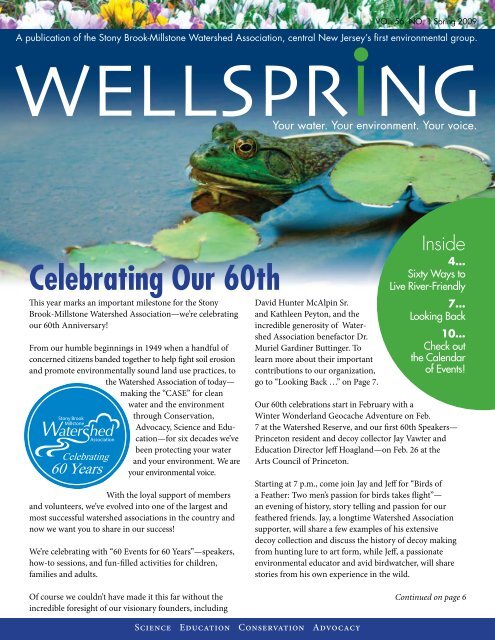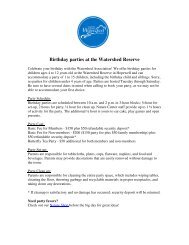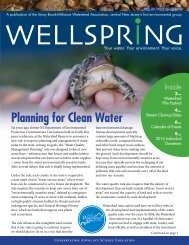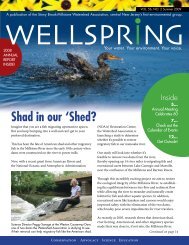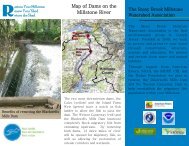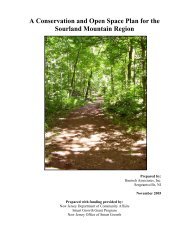Spring 2009 - The Stony Brook-Millstone Watershed Association
Spring 2009 - The Stony Brook-Millstone Watershed Association
Spring 2009 - The Stony Brook-Millstone Watershed Association
Create successful ePaper yourself
Turn your PDF publications into a flip-book with our unique Google optimized e-Paper software.
FROM THE EXECUTIVE DIRECTORSix Decades of Determination<strong>The</strong> occasion of our 60thAnniversary is a time ofdeep reflection for me. I’vebeen poking around oldboard minutes, memos, andnewsletters to get a senseof what previous Directorswere thinking when theywere in my shoes.<strong>The</strong> <strong>Watershed</strong> <strong>Association</strong> hired James Lawrence to beour first Executive Director in the spring of 1953. Mr.Lawrence assumed a fledgling organization with $3,857in the bank and an active group of volunteers that includedDavid McAlpin Sr., Paul VanWegan, John Faussett, Jr., and<strong>The</strong>ordore Reed.Mr. Lawrence started the organization’s newsletter, writingthat: “<strong>The</strong> road ahead is an uphill climb, and there is noresting... But we are making progress, and gradually theland will begin to show it. Still, it all takes patience. It takescourage.”Malcolm Crooks was hired in 1955 and led us for an activeeight years. We were involved in watershed restoration andwater supply issues and engaged municipalities to keepdevelopments out of floodplains. Mr. Crooks reports ofattending “smoke-filled municipal meetings where thecigar and cigarette smoke was just terrible.”Richard Thorsell worked closely with Board President PaulVanWegan for much of his tenure from 1963 to 1970. <strong>The</strong>organization launched a long effort to keep I-95 from beingbuilt through the Hopewell Valley, became an active advocatefor open space, and was transformed by the extremelygenerous gift of land from Dr. Muriel Gardiner Buttinger,which would eventually total 535 acres.<strong>The</strong> <strong>Watershed</strong> <strong>Association</strong>’s involvement in state andlocal environmental issues intensified under Ian Walker,Executive Director from 1970 to 1975. <strong>The</strong> organizationcontinued the battle against I-95, fought off a proposedsewer interceptor between Hopewell and Princeton,and helped block dumping of industrial waste in SouthBrunswick, among other issues.Adelle Mitchelle continued the <strong>Watershed</strong> <strong>Association</strong>’sstrong advocacy, expanded our educational programming,and presided over intense internal debate overwhether the organization should accept the 88-acreWargo Farm, which Dr. Buttinger proposed to purchaseand deed to us to be managed as a model farm.Jim Gaffney another strong advocate took the helmin 1980. Mr. Gaffney helped engineer a managementplan for the <strong>Watershed</strong> Reserve, initiated the <strong>Watershed</strong>Organic Farm, and ushered in a new era of environmentaleducation by hiring Jeff Hoagland as educationdirector in 1984.Todd Bryan was the Director from 1985 to 1989, aperiod during which we launched programs that wouldevolve into the Northeast Organic Farming <strong>Association</strong>and D&R Greenway Land Trust. <strong>The</strong> organizationhelped pass the NJ Freshwater Wetlands ProtectionAct of 1987 and protect the Princeton Institute Woods.Patricia Reed Begel took the helm in 1989, shifting ourfocus towards environmental education, organic farming,and financial stability. <strong>The</strong> Buttinger Nature Centerwas opened during her time.<strong>The</strong> <strong>Watershed</strong> <strong>Association</strong> launched StreamWatch,introduced a model stream corridor protection ordinance,and waged a successful $1.5 million capital campaignto shore up our facilities and endowment during JamieSapoch’s tenure from 1991 to 1997.George Hawkins expanded our policy efforts, assistedtowns with municipal planning, helped secure strongstate stormwater rules, and defeated the proposed<strong>Millstone</strong> Bypass. <strong>The</strong> <strong>Watershed</strong> Reserve also grew to830-acres during his time from1997 through 2004.I am extremely proud to be a part of the <strong>Watershed</strong>’ssix decades of determination. We owe a lot to the menand women who preceded me as your Director.2 <strong>Spring</strong> <strong>2009</strong> www.thewatershed.org
CONSERVATION BEGINS AT HOME60 Ways to Live River-FriendlyEverything we do has an impact on the health of ourwater and environment, but it doesn’t take much to makea difference. Here are 60 River-Friendly things you cando to help protect clean water and healthy habitats in ourregion. How many ways can you help?IN YOUR LAWN:take a soil testleave grass clippings on the lawnmaintain a mowing height at 3 inchesregularly over-seed the lawnmulch leaves into the lawn with a mowerallow the lawn to go dormant in the summeraerate the lawnuse slow release or organic fertilizersminimize turf/lawn areasDEALING WITH INSECTS AND WEEDS:scout the property for pest insects and weedstry non-chemical methods to control insects and weedstolerate some pests in the lawn and gardenminimize pesticide use and spot spray pesticidesuse low toxic or organic pesticidesalways follow label directionsdispose of household chemicals properlyMINIMIZING POLLUTION IN STORMWATER RUNOFF:direct gutters onto vegetated areasplant groundcovers or use mulch to cover exposed soil areasminimize impervious (non-porous) surfacespick up and dispose of pet wastekeep storm drains free of debrisQuick ‘Green’ Tips For Inside Your Home• Be an ‘energy star’ and choose Energy Star energysavingappliances• Light the way with compact fluorescent or LED (lightemitting diode) light bulbs• Clean ‘green’ with products that contain non-toxic,biodegradable ingredients• Go with the low-flow and look for WaterSense labeledplumbing fixtures and appliances to reduce water use• Be teRRRific—Reduce, reuse, recycle!keep excess fertilizer off sidewalksminimize winter salt usecreate a rain gardenmaintain a vegetated buffer along water body edgesfence livestock away from water bodiesMAINTAINING SEPTIC SYSTEMS:know septic tank and drain field locationsinspect and pump septic systems routinelyavoid antibacterial products with septic systemsrepair leaking or failing septic systemsCONSERVING WATER:mulch around trees, shrubs, and garden bedsinstall a rain barrel on building downspoutswater less often, but for longer timewater during early morning hourshand water or use drip irrigationattach shut-off nozzles to watering hosescheck and repair leaks on faucets, hoses, and sprinklersgroup plants according to their water needswater when plants need watering, rather than on a set scheduleavoid watering on windy daysuse a rain gaugeuse a broom not a hose to clean sidewalksENCOURAGING WILDLIFE:plant native plantsremove invasive plantsprovide a variety of herbaceous plants, shrubs, and treesinstall bird and bat housesleave dead trees and brush for wildlifehave a pond and/or bird bathprovide food source plants for wildlifeplant a butterfly gardenGENERAL GARDENING AND PLANT HEALTH:create a compost pileuse compost as a lawn/garden amendmentproperly prune trees and shrubskeep garden tools and mower blades sharp and cleanlearn to identify five beneficial insectsEDUCATIONAL:attend an educational class or hikeestablish a conservation easement on your propertyget involved in your community’s efforts to protect the environmentpromote your actions by sharing information with othersAnd here it is…the 60th thing you can doBecome River-Friendly Certified!Call Amy Weaver at 609-737-3735 x 37or email river-friendly@thewatershed.org.River-Friendly is made possible with support from the Horizon Foundation.4 <strong>Spring</strong> <strong>2009</strong> www.thewatershed.org
Speaking of nature‘Wild’ Lessonsby Jeff HoaglandI have always had a passion for nature. I grew up in aneighborhood, full of children, next to a state park. Mychildhood was filled with the typical kid play of that era—kick-the-can, hide-and-seek, stickball and other assortedgames and sports. <strong>The</strong> fields and forests surrounding usoffered unbridled adventure—there were lands to explore,forts to build, trees to climb, and trails to make. But even atthis carefree age, I realized that the “wild” was more thanjust a backdrop for our activities.I dwelled in the joys of nature every day. I watched antscarry my food offerings back to their nest. I climbedto watch eggs hatch in a dove nest up in a pine tree. Idiscovered whole “towns” of crayfish in the stream andmet a whole army of garter snakes emerging from hibernation.<strong>The</strong>re were countless excursions and discoveriesthat filled me with delight but nothing brought me moresatisfaction than to share this wonder with others.Even in those days this was mission work. I had discoveredthat this world we considered “ours”, to do with as weplease, was full of other “people” who might be harmed byour actions. Those “people”—the trees, the wildflowers andferns, the salamanders and snakes, bugs, birds, and more—were everywhere around us. Though they had things toteach us—how to be patient, how to go with the flow, howto persist—they were being consistently ignored. Thus atan early age, I became not only a naturalist, but also anadvocate, and, an educator.I have been fortunate to inhabit this mission privately andprofessionally. I am grateful that I have been able to makea living by sharing nature with children (and others), notjust for the joy of it but in the larger context of protectingour environment. <strong>The</strong> <strong>Watershed</strong> <strong>Association</strong> has been theperfect home for this work. This seed-sewing, foundationbuildingwork with children is complemented by advocacyand education with municipal officials, scientific researchin the field, and land preservation efforts.Through hands-on lessons at the <strong>Watershed</strong> <strong>Association</strong>students learn that we all have a habitat and that theneeds of other beings are not so dramatically differentthan ours. <strong>The</strong>y learn that trees are busy much of theirlives, not just giving us shade, but bearing fruit, providingother resources and giving us fresh, clean oxygen toEducation Director Jeff Hoagland with students from TimberlaneMiddle School.breathe. <strong>The</strong>y learn that all of us, plant and animal, are connectedin a vast, endless web of life.Students also learn that clean water is a resource vital to allbeings, and that we as humans have a responsibility to carefor this resource. <strong>The</strong>y learn this through direct interactionwith local waterways, by using scientific methods, examiningthe waters, and by meeting some of the beings who inhabitour waterways.I am convinced that this is critical work. Give students theopportunity to hold their stream water in a test tube andanalyze it, to meet the small creatures who are the “canariesin the coal mine” of the stream, to watch a kingfisher plungeheadfirst into a pool for a meal—these are memorable andlife-affirming lessons. Give the students the future, informed byscience and inspiring experiences, they will make a difference.Rick LearFormer Teacher-Naturalist InternMiddlesex CountyOpen Space CoordinatorWhy is the<strong>Watershed</strong> <strong>Association</strong> important?“<strong>The</strong> <strong>Watershed</strong> <strong>Association</strong> presents a balanced voiceof reason on environmental issues … and is importantbecause of its constant and crucial attempt to bringpeople back to what matters—connection with thebigger picture of how we fit in this planet; and thenatural healing power and relief offered by the naturalworld. <strong>The</strong> education programs play an important rolein this respect.”<strong>Spring</strong> <strong>2009</strong> www.thewatershed.org 5
Celebrating 60Looking Back...It is 1949, Harry Truman is president, the Yankeesdefeat the <strong>Brook</strong>lyn Dodgers in the World Series,and a major milestone is reached in the protectionof the environment in central New Jersey.Concerned about agricultural runoff, soil erosion andstream sedimentation from the more than 300 farmsdotting the 265-square-mile <strong>Stony</strong> <strong>Brook</strong>-<strong>Millstone</strong><strong>Watershed</strong> at the time, a handful of citizens band togetherto form the <strong>Stony</strong> <strong>Brook</strong>-<strong>Millstone</strong> <strong>Watershed</strong> <strong>Association</strong>.Who were our early visionaries? Here’s a closer look atthree important figures in <strong>Watershed</strong> <strong>Association</strong> history:David Hunter McAlpin Sr., <strong>Watershed</strong> <strong>Association</strong> founderA charter trustee of the Conservation Foundation, whichmerged with the World Wildlife Fund in 1990, Mr. McAlpinsought the advice and support of Conservation Foundationfounder Henry Fairfield Osborn Jr. who saw a critical needfor grassroots organizations to protect the environmentat the watershed scale. With Osborn’s guiding spirit, Mr.McAlpin and a committee of five helped attract enoughinterest in soil erosion and forest management issues totransform the all-volunteer group into a permanent fixturein the community. Mr. McAlpin also served as <strong>Association</strong>President and Membership Chairman during his tenure.Kathleen Peyton, <strong>Watershed</strong> <strong>Association</strong> founder<strong>The</strong> Conservation Chair for the Garden Club of Princeton,Mrs. Peyton took interest in one of the nation’s firstwatershed association—the Brandywine Valley <strong>Watershed</strong><strong>Association</strong>—and felt it could work as a model for anorganization to protect natural resources in central NewJersey. Part of a committee of five, she helped identify the265-square-mile region now known as the <strong>Stony</strong> <strong>Brook</strong>-<strong>Millstone</strong> <strong>Watershed</strong> and solicited the help of the SoilConservation Service to take on the first surveys of thisarea for soil erosion.Dr. Muriel Gardiner Buttinger, <strong>Watershed</strong><strong>Association</strong> benefactorDr. Muriel Gardiner Buttinger was the <strong>Watershed</strong> <strong>Association</strong>’sprimary benefactor. A student studying medicine inVienna when World War II broke out, Dr. Buttinger riskedher life working to get Jews out of the country—for whichshe was later awarded the Austrian Cross of Honor. Afterthe war, she and her family moved to <strong>Brook</strong>dale Farm inHopewell. A psychiatrist dedicated to children and an earlyand avid supporter of the <strong>Watershed</strong> <strong>Association</strong>’s work,Muriel—inspired by her daughter Connie’s unreservedpassion for the environment—ultimately gifted her farm,more than 400 acres of land, to the <strong>Watershed</strong> <strong>Association</strong>laying the foundation for the <strong>Watershed</strong> Reserve andHoney <strong>Brook</strong> Organic Farm.See our Historical Timeline on pages 8 and 9 to learn moreabout the important milestones and achievements of the<strong>Stony</strong> <strong>Brook</strong>-<strong>Millstone</strong> <strong>Watershed</strong> <strong>Association</strong>.David McAlpin Jr.Son of Founding MemberFormer Trustee &Board PresidentWhere do you see the <strong>Watershed</strong><strong>Association</strong> in the years to come?“My father was one of the founding members of the<strong>Watershed</strong> <strong>Association</strong>. He had a long view and feltthat it was urgent that attention be paid to help ourenvironment. <strong>The</strong> initial emphasis was on soil erosionand working with farmers to persuade them to adoptenvironmental practices. In the future, the <strong>Watershed</strong>needs to continue to be involved in local efforts to protectthe health of the natural environment, while at the sametime helping to guide public opinion and lead the way inshowing how we, as a society, can become more ‘green’and use less fossil fuels to combat global warming.”<strong>Spring</strong> <strong>2009</strong> www.thewatershed.org 7
March 20Underwater Worlds: A photographic journeyFriday, 7:30 PM, Kingsford Room, <strong>Watershed</strong> Reserve, 31Titus Mill Road, Pennington, FREEFor 60 years the <strong>Watershed</strong> <strong>Association</strong> has been protectingyour water and environment. For 30 years award-winningunderwater photographer and watershed resident JeffRotman has been capturing the wonder of our underwaterworlds on camera. From sharks to sea anemones, join Jefffor a pictorial tour of his global underwater adventures.Recognized as the BBC Underwater Wildlife Photographerof the Year, Jeff has been published in top national magazinesand authored numerous books for children and adults,which he will be signing at the event. Register to Attend:Call Nancy Apple at (609) 737-3735 x10.March 28Build a BirdhouseSaturday, 10 AM–12 PM; Families; Fee per birdhouse: $12Experience the joy and excitement of watching a bird raiseits family by building your own birdhouse with one ofour Naturalists. As we walk the Reserve property, we willexamine several natural bird homes and discover some ofthe truly strange places birds will build their nests. Eachparticipant can construct their own birdhouse from a kitand take it home.April 4Vernal Pools of the Sourland MountainsSaturday; 10 AM–12 PM; Families and Adults; FREEVernal pools are an often overlooked and unique featurein some of our field and forest ecosystems. <strong>The</strong>se poolsare filled with water during the spring breeding seasonand harbor a variety of life including amphibians, insects,reptiles, plants and other wildlife. Join Naturalist AllisonJackson on this hike and explore vernal pools in theSourland Mountains, learning about life cycles and thefood web, perhaps encountering wood frogs or spottedsalamanders as well as a variety of other native creatures.This program does not meet at the Buttinger NatureCenter. This program is co-sponsored by the SourlandsPlanning Council.April 11Nature Camouflage Egg HuntSaturday, 10 AM; Families (children 3–11 years old)Fee per child: $7 M/$10 NM; No charge for adultsJoin our Naturalists for the ultimate egg hunt challenge.Wander through the fields and forests of our nature reserveto see how many naturally dyed eggs you can discover.What else will we find along the way? Claim a special prizefor finding the ‘golden egg’.April 15Early Birds and Other <strong>Spring</strong> HappeningsWednesday, 8:30–10:30 AM; Adults; FREEJoin this weekday hike on the <strong>Watershed</strong> Reserve withNaturalist Jeff Hoagland in search of early migratory birds.We will walk through field and forest and out to the <strong>Stony</strong><strong>Brook</strong> also encountering spring wildflowers and other signsof spring. This program is co-sponsored by the WashingtonCrossing Audubon Society.April 18Foraging for Wild EdiblesSaturday, 8:30 AM–12:30 PM; Adults; Offered throughPrinceton Adult SchoolJoin Jeff Hoagland on this delicious hike in search ofwild edible plants. <strong>The</strong> fields and forest of the <strong>Watershed</strong>Reserve harbor a wealth of edible plants representing thetraditions of our European roots and Native America.Learn to identify and enjoy a variety of wild edible plants.Our samplings will include the cattail, garlic mustard,violets, wild leeks, spring beauty, wild ginger, cut-leavedtoothwort and much, much more. This program is offeredthrough the Princeton Adult School. Please register atwww.princetonadultschool.org.April 24Frog SlogFriday, 8 PM; Families (children 6+) and Adults;Fee: $8 M/$12 NMDiscover the secret life of frogs on this special nighthike with Jeff Hoagland at the soggy and sonic landscapeof the <strong>Watershed</strong> <strong>Association</strong>’s pond. Learn where andwhen to find different frogs and toads and learn howto distinguish one frog “song” from another. Come withsharp ears, sharp eyes (and a flashlight), and be preparedfor wet, frog-slog conditions.April 25 & 26May 2 & 33rd Annual <strong>Watershed</strong>-wide Stream Clean-upsSaturday and Sunday, two weekendsJoin us for the 3rd Annual <strong>Watershed</strong>-wide StreamCleanups! Cleanups in Cranbury, East Windsor, Franklin,Hopewell, Hightstown, Lawrence, <strong>Millstone</strong>, Monroe,Princeton, Plainsboro, and West Windsor. Location detailscan be viewed on our Web site www.thewatershed.orgor call Anneli TerryNelson for more information (609)737-3735 x14.<strong>Spring</strong> <strong>2009</strong> www.thewatershed.org 11
April 27Annual MeetingMonday, 5:30–7:30 PM, <strong>Watershed</strong> Reserve, 31 Titus MillRoad, PenningtonCome celebrate our 60th Anniversary! Join us forrefreshments and fun as we honor longtime volunteersand the out standing achievements of community leaders.Don’t miss this chance to mix and mingle with fellow<strong>Watershed</strong> <strong>Association</strong> members, meet the staff, andhear from an exciting keynote speaker. Stay tuned formore details!May 9World Series of BirdingHelp support conservation and education by making apledge to the <strong>Stony</strong> <strong>Brook</strong>-<strong>Millstone</strong> <strong>Watershed</strong>’s “<strong>The</strong>Birds of Play” team, as they compete in the <strong>2009</strong> WorldSeries of Birding. We will race the clock to see how manyspecies of birds can be found throughout the <strong>Millstone</strong>River watershed. Our work will help support bird andhabitat conservation throughout the state, while yourpledge will support education efforts at the ButtingerNature Center. For more information about WSB,contact the Buttinger Nature Center at 609-737-7592or visit our website at www.thewatershed.org.May 16Exploring John Witherspoon Woodswith Dr. Henry HornSaturday, 9 AM; Adults; FREEJoin Henry Horn, Professor of Ecology and EvolutionaryBiology at Princeton University for this enlighteninglook at the ecology, geology and human history of thisunique forest in Princeton. During this adult orientedhike, discover life and death in the forest while examininga myriad of adaptations in various species. This hikecourses through mature forest, along old stonewalls,across small streams and through a memorable boulderfield including Devil’s Cave. This program is co-sponsoredby the Washington Crossing Audubon Society.May 17Summer Camp Family Open HouseSunday, 1–4 PM; Families of first-time campersMeet and greet Summer Camp Director Tammy Gotschthis afternoon! Tour the Reserve, ask questions, andregister your child for summer camp if you haven’t alreadydone so (availability in all sessions is not guaranteed). Thisopen house is for first-time camp families, not returningcampers. Held rain or shine—pre-registration to attendopen house is not required.May 30Wild and WoollySaturday, 10:30 AM–12:30 PM; Families (children 6+) andAdults; Fee: $6M/$9NMA wool sweater comes from a store… or does it? Enjoya demonstration of wool spinning by Naturalist TammyGotsch, hear a ‘woolly’ story and make your own dropspindleto bring home and learn to spin! Space is verylimited and pre-registration is required.June 6Great <strong>Watershed</strong> Stream Exploration—Bedens <strong>Brook</strong> in Opossum Road WoodsSaturday, 10 AM–12 PM; Families and Adults; FREEJoin us to visit the Bedens <strong>Brook</strong> in Opossum RoadWoods in Montgomery Township. Part of an ongoingseries of community stream explorations, come explorethe web of life that connects the aquatic environment ofthe stream and the surrounding terrestrial habitat using avariety of tools, including seines and nets. Meet a varietyof creatures including water pennies, caddisflies, tadpoles,pumpkinseeds, and more while learning about our rolein the health of our streams. Bring old sneakers forwading, dry shoes to change into, and a sense of wonder!This program is co-sponsored by the Washington CrossingAudubon Society.June 20Butterfly House Opening/Buttinger NatureCenter Open HouseSaturday, 10 AM–2 PM; Families and Adults; FREEWelcome the butterflies back to the Kate Gorrie ButterflyHouse. Naturalists will be on hand all day to lead toursand answer questions about native butterflies, host plantsand butterfly lifecycles. Plan to also visit the animals anddisplays in the Buttinger Nature Center. Event is freebut donations for maintenance of butterfly house aregladly accepted. All <strong>Watershed</strong> members will receivea 20% discount on Nature Shop purchases that day.Pre-registration is not required.June 24Exploring the Night: Firefly ParadeWednesday, 8:30 PM; Families and Adults; Fee: $8 M/$12 NMEnjoy “nature’s fireworks” on the <strong>Watershed</strong> Reserve. JoinJeff Hoagland for an encounter with magic—learn aboutthe secret lives of the lightning bug, from glowworm toadult, and meet a variety of species, identifying them bytheir different flash patterns. Scratchboards are providedto create your very own firefly art! This popular annualevent always fills up—space is limited and pre-registrationis required.12 <strong>Spring</strong> <strong>2009</strong> www.thewatershed.org
Children’s ProgramsApril 6/7 and 8/9<strong>Spring</strong> Mini-Camp I and IITwo-day sessions; Monday/Tuesday or Wednesday/Thursday; 9:30 AM–4 PMExtended day available 8:30AM–5:30PM at extra cost;Children 6–12 years oldFee per child: $110 M/$135 NM; Extended day fee:$20 per child per dayJoin the <strong>Watershed</strong> Teacher Naturalists on a two-dayadventure in field and forest during spring school vacation.Our activities will focus on the arrival of spring. We willbushwhack through the Reserve in search of nesting volesand geese, watch for emerging wildflowers, insects andamphibians. We might visit the Pond or <strong>Stony</strong> <strong>Brook</strong> tolook for the last signs of winter and the beginning of a newseason. Bring your lunch daily. Sessions are conductedoutdoors. Choose either Monday/Tuesday or Wednesday/Thursday. Registration is required, no day of event walkins.Full payment is required at time of registration.April 14/15<strong>Spring</strong> Mini-Camp IIITuesday/Wednesday; 9:30 AM–4 PM;Extended day available 8:30 AM–5:30 PM at extra cost;Children 6–12 years oldFee per child: $110 M/$135 NM; Extended day fee:$20 per child per dayJoin the <strong>Watershed</strong> Teacher Naturalists on a two-dayadventure in field and forest during spring school vacation.Our activities will focus on the arrival of spring. We willbushwhack through the Reserve in search of nesting volesand geese, watch for emerging wildflowers, insects andamphibians. We might visit the Pond or <strong>Stony</strong> <strong>Brook</strong> tolook for the last signs of winter and the beginning of a newseason. Bring your lunch daily. Sessions are conductedoutdoors. Registration is required, no day of event walk-ins.Full payment is required at time of registration.April 17, 24May 1, 8Movin’ Naturally—Yoga for PreschoolersChildren 3–5 years old; parent must stay with child under4 years oldFridays, 3:30–4:15 PMFee per session: $10 M/$15 NM or Fee per series:$35 M/$60 NMExperience nature by becoming part of it. In this yogainspired series taught by Naturalist/yoga instructor AllisonJackson, children will explore nature through creativemovement, activities and games. Wear comfortableclothing for moving outdoors. Please bring a yoga mat.June 27Boy Scouts of America ‘Insect Study’Merit BadgeSaturday, 9:30 AM–12:30 PM; Boy Scouts 11 years andolder; Fee: $15 per scoutJoin Education Director/BSA Merit Badge Counselor JeffHoagland for this half-day workshop, designed to help BoyScouts earn the Insect Study merit badge. Out on the trailsin field, forest, and streamside scouts will learn to observeand identify a wide variety of insects, discovering the secretlives of our smallest neighbors.June 30-July 2Kindercamp—A Mini-Camp forKindergartenersTuesday through Thursday, 9:30 AM–12 PM; childrenfinished with Kindergarten and entering grade 1 inSeptember; Fee: $75 plus current <strong>Watershed</strong> familymembership requiredThis special 3-day summer mini-camp is designed forthe young child to transition into our summer campexperience. Conducted by both our Teacher-Naturalistsand Summer Camp Staff, your young camper willexperience all of the usual natural fun the <strong>Watershed</strong> offersevery summer—including a pond exploration and insectsafari. Space is limited—registration is required.July 6First Day of Summer CampSix weeks of outdoor fun and exploration for childrenentering grades 1 through 9! Check your mailbox forour <strong>2009</strong> Camp brochure—visit our website or callthe Buttinger Nature Center at 609-737-7592 for moreinformation.June 22 through August 17Butterfly House Weekly ToursMondays, 10–11 AM; Families and Adults; FREEJoin one of the staff naturalists for an insider’s view ofwhat’s happening in the Kate Gorrie Butterfly House.Learn about host plants for butterfly larva, matingstrategies for different butterflies, caterpillar predatorsand parasites, native New Jersey butterfly lifecyclesand much more. This program co-sponsored by theWashington Crossing Audubon Society.<strong>Spring</strong> <strong>2009</strong> www.thewatershed.org 13
Board of TrusteesCandace L. Preston, ChairJohn Ellis, Vice ChairMargaret Gorrie, Vice ChairLorraine A. Sciarra, SecretaryZvi Eiref, TreasurerDr. William M. AyersKathleen BigginsLori CitroneElliot CohenBarbara Griffin ColePeter E. GibsonWilliam H.B. HamillRobert H. Harris, Ph.D.Katharine P. HeinsRobert HillasRichard LevandowskiBrian J. McDonaldNelson ObusThomas O’NeillRichard O. ScribnerMargaret SieckTee WilliamsStaffJim Waltman, Executive DirectorRich Cavallaro, ControllerJennifer Coffey, Policy DirectorJeff Hoagland, Education DirectorPolly Ranson, Interim Membership & Development DirectorPeggy Savage, Science DirectorBay Weber, Conservation DirectorRichard AnthesNancy AppleBeth AprilTammy GotschAlyse GreenbergNicholas HoAllison JacksonMolly JonesLisa JordanJoan McGeeGwen McNamaraMaryann PolefkaAnneli TerryNelsonJohn TomaszewskiAmy Weaver* EMAIL: To contact staff by email, use the firstletter of the person’s first name, followed by the lastname: for example, jwaltman@thewatershed.orgFor more information on the latest <strong>Watershed</strong> News,visit: www.thewatershed.org<strong>Stony</strong> <strong>Brook</strong>-<strong>Millstone</strong> <strong>Watershed</strong> <strong>Association</strong>31 Titus Mill Road, Pennington NJ 08534Main office phone: (609) 737-3735 Fax: (609)737-3075<strong>Spring</strong> <strong>2009</strong> www.thewatershed.org 15Our TownsCranburyEast AmwellEast WindsorFranklinHightstownHillsboroughHopewell BoroughHopewell TownshipLawrenceManalapanManville<strong>Millstone</strong> Borough<strong>Millstone</strong> TownshipShare Your<strong>Watershed</strong> MemoriesHow have you and your family beeninvolved with the <strong>Watershed</strong> <strong>Association</strong>?As we celebrate our 60th Anniversary we wantto hear from you—What makes you proud aboutthe work we do? How have we made an impacton your life? What are some of your favoriteactivities at the <strong>Watershed</strong>? Why is clean waterand a healthy environment important to you?Tales long and short, serious and humorous—all are welcome! Simply email your thoughtsto gmacnamara@thewatershed.org subject line:60th <strong>Watershed</strong> Memories. Your story couldappear in an upcoming issue of Wellspring!MonroeMontgomeryNorth BrunswickPenningtonPlainsboroPrinceton BoroughPrinceton TownshipRobbinsvilleRocky HillRooseveltSouth BrunswickWest AmwellWest Windsor
31 Titus Mill RoadPennington, NJ 08534Your water. Your environment. Your voice.NON-PROFIT ORG.U.S. POSTAGEPAIDPENNINGTON, NJPERMIT NO. 7Printed on recycled contentE paper with soy-based inks<strong>2009</strong> NATURE ANDENVIRONMENTAL SUMMER DAY CAMPCome to the <strong>Watershed</strong> to enjoy all of your favorite spots around the <strong>Watershed</strong> Reserve!Summer Camp begins July 6 and runs for six weeks, Monday through Friday, from 9 AM to 4 PM.What’s NEW for this summer?• Expanded program offerings based on weekly themes!• Sign up for multiple weeks—come for one week or all six!• New trip destinations!• Camp fee discount for siblings OR multiple week registration!• OPEN HOUSE on May 17 from 1–4 PM for first time campers and their families!SPECIAL Summer Mini-Camp offerings include:• ‘Kindercamp’ mini-camp in June for children finished with kindergarten!• ‘Magic and Mapmaking’ mini-camp in AugustVisit our Web site for more information, fees and dates: www.thewatershed.org.


